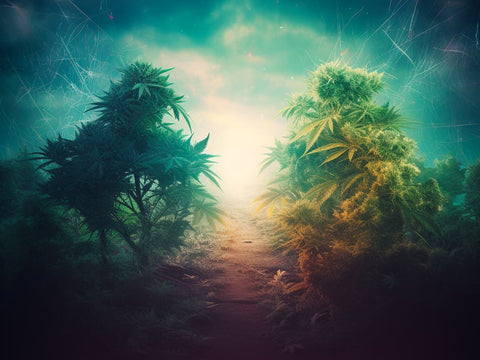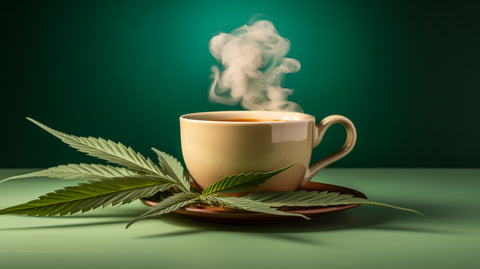In recent years, there is no denying the rise in popularity of CBD flower, an alternative to traditional marijuana. With this increase in demand comes more people questioning the overall taste profile of CBD weed compared to real weed. This article will examine and break down these variations in taste, as well as explore the factors influencing such differences.
The Basic Taste Differences between CBD Flower and Real Weed
There are several variables that come into play when we talk about the flavours experienced while consuming both types of cannabis plants. Here's a comparison:
- THC vs CBD potency: One of the significant differences between consuming traditional real weed and CBD flower is the ratio of THC (psychoactive) and CBD (non-psychoactive) content. When smoking or vaping weed, users often feel the characteristic "buzz" associated with THC; however, this feeling does not typically reside when using CBD-dominant strains. Such a difference can directly affect how one perceives its taste.
- Taste-profile variations in strains: Both real weed and CBD flower consist of multiple strains with unique flavour profiles, thanks to their diverse terpenes and flavonoids compositions. For instance, some weed strains possess strong earthy tastes, while others bear fruity or sweet notes. Similarly, different CBD flowers may also feature tastes ranging from floral to citrusy or even woody flavours. These flavours vary from strain to strain in both plants.
In summary, it would be incorrect to assume that all CBD weeds and real weeds share identical taste profiles or broad generalizations. Consumers should expect natural flavour diversities among various strains of each type.
A Closer Look at Terpenes: What Impacts Flavour?
Terpenes play a significant role in creating the flavour profile of both traditional weed and CBD flower. As organic compounds found in many plants, terpenes contribute to not only their taste but also their aroma.
Why are Terpenes Essential for Taste?
Terpenes fashion unique tastes and smells within different strains by interacting with other compounds present in the plant, such as flavonoids and cannabinoids like THC and CBD. Marijuana and hemp plants (from which CBD flower is derived) contain over 100 distinct terpenes, each affecting its final taste and smell outcomes.
How Do Terpenes Differ Between CBD Flower and Real Weed?
While the difference between the two types of cannabis plants lies in their THC and CBD concentrations, terpene profiles can be found shared across various strains of both marijuana and hemp plants. This implies that it's possible to find similar flavour profiles in both a high-CBD strain and a traditional marijuana strain depending on their specific terpene compositions.
The Influence of Cultivation Techniques and Quality Control on CBD Flower's Taste
Beyond natural components, the quality of CBD flower cultivated and processed can significantly impact how similar or different its taste is compared to real weed. Factors such as growth methods, harvesting techniques, and curing processes come into play when discussing taste differences between these two plant varieties.
- Growth Method: The way in which the plants are grown has definite effects on their eventual taste. For example, given adequate conditions such as sunlight and nutrient-rich soil, organically-grown plants may produce a superior taste compared to those grown hydroponically or chemically.
- Harvesting Techniques: Proper timing of harvest has a direct influence on the taste of both real weed and CBD flower. If harvested too early, the plants may have an undeveloped terpene profile with weaker flavours. Conversely, overripe plants would yield different tastes as well.
- Curing Process: How the plant is cured will also significantly impact its final taste. A poorly-cured batch of cannabis or hemp will display dampness, lack of aroma or flavour, harsh smoke, or even trace amounts of mould. These shortcomings can drastically affect the experience and enjoyment of consuming both real weed and CBD flower.
As evident, multiple external factors contribute to creating the overall taste profile of both CBD flowers and real weed. Recognizing these variables can help users make educated decisions about their purchases when seeking specific taste experiences.
Taste Testing: The Best Way to Compare CBD Flower and Real Weed Flavours
The absence of one-size-fits-all answers regarding whether CBD weed tastes like real weed directs interested consumers towards personally exploring various types of strains from both of these plant categories. By sampling diverse options, one can better understand the unique characteristics each strain possesses in terms of flavour, aroma, and experience. Taste testing can provide individuals with insight into what they genuinely prefer and assist them in making more informed decisions about future consumption.
In conclusion, optimizing your personal preferences in the often-overlapping realms of CBD flower and marijuana lies within the realm of trial and error. Acknowledging and experimenting with varying terpenes, cultivating techniques, and individual strains enables an informed decision-making process while selecting enjoyable taste profiles that cater to each user's desires.
Disclaimer:
This article is written independently and does not necessarily reflect the views of HempHash



